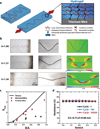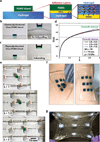Stretchable Hydrogel Electronics and Devices
- PMID: 26639322
- PMCID: PMC4896855
- DOI: 10.1002/adma.201504152
Stretchable Hydrogel Electronics and Devices
Abstract
Stretchable hydrogel electronics and devices are designed by integrating stretchable conductors, functional chips, drug-delivery channels, and reservoirs into stretchable, robust, and biocompatible hydrogel matrices. Novel applications include a smart wound dressing capable of sensing the temperatures of various locations on the skin, delivering different drugs to these locations, and subsequently maintaining sustained release of drugs.
Keywords: biointegrated electronics; drug delivery; flexible electronics; hydrogels; wearable devices.
© 2015 WILEY-VCH Verlag GmbH & Co. KGaA, Weinheim.
Figures





References
-
- Beebe DJ, Moore JS, Bauer JM, Yu Q, Liu RH, Devadoss C, Jo BH. Nature. 2000;404:588. - PubMed
-
- Dong L, Agarwal AK, Beebe DJ, Jiang HR. Nature. 2006;442:551. - PubMed
-
- Debord JD, Eustis S, Debord SB, Lofye MT, Lyon LA. Advanced Materials. 2002;14:658.
-
- Iwayama Y, Yamanaka J, Takiguchi Y, Takasaka M, Ito K, Shinohara T, Sawada T, Yonese M. Langmuir. 2003;19:977.
-
- Sidorenko A, Krupenkin T, Taylor A, Fratzl P, Aizenberg J. Science. 2007;315:487. - PubMed
Grants and funding
LinkOut - more resources
Full Text Sources
Other Literature Sources

